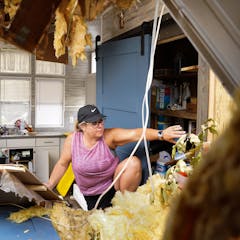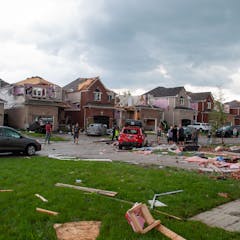
Articles on Floods
Displaying 81 - 100 of 412 articles

La Niña is officially here for the third year in a row. You probably associate it with flooding, but how might it affect future drought and bushfires? And could a fourth La Niña be possible?

The culpability for Pakistan’s catastrophic floods rests with the government and wealthy polluter countries.

Climate change will increase the frequency of both floods and droughts in Pakistan. To address these challenges, enhancing infrastructure, building dams and educating the public are necessary.

The flooding in Pakistan is the latest in a sequence of exceptional disasters in the Northern Hemisphere. How much is climate change to blame?

The world’s great rivers are see-sawing from trickles to floods.

Climate change is colliding with old factory sites where soil or water contamination still exist, and the most vulnerable populations are particularly at risk.

Telling people they have a flood risk rating of 10 is less powerful than explaining how much they’re likely to pay to deal with flooding over the next five years.

Property buybacks and managed retreat from high-risk areas were once seen as far-off options as the planet warms. Now this ‘last resort’ adaptation to climate change is an urgent priority worldwide.

Giving rivers rights would enable custodians to perform legal acts on the river’s behalf.

Governments have known about the flood risks in the Hawkesbury-Nepean Valley for more than two centuries. All have failed to protect the community.

People feel more secure knowing there’s a levee nearby - but this can backfire, leading to more development on floodplains. Australia needs to tackle the incentives behind these risky developments.

Again, thousands of residents in Western Sydney face a life-threatening flood disaster. Obviously, nature is a major culprit – but other drivers are also at play.

A warmer atmosphere can hold more water – and that makes floods harder to predict. To help, we improved one common tool used to predict floods.

Engineers, architects and builders can design and construct affordable new buildings that can resist tornadoes, floods and wildfires, but do not. We have that opportunity now.

Lismore’s residents and businesses on the floodplain need to look at relocation, not rebuilding.

The collapse of the Atlantic meridional overturning circulation would profoundly alter the anatomy of the world’s oceans and climate. New research explores the consequences.

The impacts of Russia’s invasion of Ukraine will pass, but the impacts of climate change will not.

Accra has become susceptible to floods due to encroachment on wetlands.

One weather configuration has been responsible for record-breaking downpours in Australia, South America, and South Africa this year.

Some Niger Delta residents are less concerned about oil-induced hazards and risks, or floods and erosion. They are more worried about a lack of sanitation amenities.
